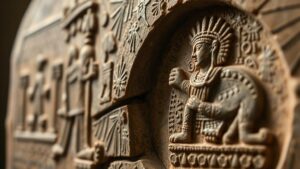How AI Can Improve Cross-Referencing of Archaeological Journals and Relic Finds
How AI Can Improve Cross-Referencing of Archaeological Journals and Relic Finds
The integration of Artificial Intelligence (AI) into archaeological research has opened new pathways for improving data management, particularly in the realm of cross-referencing archaeological journals and relic finds. Given the sheer volume of information generated daily through fieldwork, publications, and digital archives, AI offers robust methodologies to enhance the accuracy, efficiency, and accessibility of archaeological data.
Understanding Cross-Referencing in Archaeology
Cross-referencing in archaeology involves the systematic assessment of information across various sources to draw comprehensive conclusions about historical findings. Traditionally, researchers manually analyze academic journals alongside excavation reports, museum catalogs, and other documents, which can be a time-consuming process.
The Role of AI in Data Processing
AI technology enables rapid processing and analysis of extensive data sets that overwhelm human researchers. Using Natural Language Processing (NLP) algorithms, AI can extract relevant information from archaeological texts, correlating findings from multiple sources. This significantly reduces the time required for literature reviews and enables researchers to focus on interpretation rather than data collection.
Concrete Examples of AI Applications
- Text Mining: Tools like Apache Tika allow researchers to mine archaeological journal articles for specific terms related to relic collections. This functionality enables the identification of trends and themes across published literature, as demonstrated by a study published in The Journal of Archaeological Science in 2022, which consolidated over 5,000 archaeological papers.
- Databases and Knowledge Graphs: Projects such as Linked Open Data for Archaeology utilize AI to create interconnected databases that streamline access to archaeological data. By implementing semantic web technologies, researchers can find relationships between various archaeological finds and scholarly articles published from 2000 to 2023, enabling comprehensive research.
Challenges and Limitations of AI Integration
Despite the advantages, the application of AI in archaeology is not without its challenges. Much of the archaeological data remains unstructured, making it difficult for current AI methodologies to process effectively. Also, there may be inherent biases in the training data that could influence the accuracy of AI models.
- Quality of Data: Archaeological findings are often incomplete or ill-documented. AI systems trained on flawed data may produce misleading results.
- Interdisciplinary Skills: Effective AI integration requires collaboration between archaeologists and computer scientists. This necessitates a skill set that not all teams possess.
Real-World Applications and Case Studies
Useing AI in archaeological studies can yield tangible benefits, as evidenced by the CAA (Computer Applications and Quantitative Methods in Archaeology) conference held in 2023. Here, numerous case studies showcased successful interactions between AI technologies and archaeological fieldwork.
One notable example is the application of machine learning algorithms in analyzing satellite imagery to detect potential archaeological sites in the Andes of Peru. By processing historical data from 1950 to present, machine learning models identified sites that had previously gone unrecognized, leading to successful excavations in 2024.
Future Implications for Archaeology
The potential benefits of AI extend beyond mere data processing. As AI systems continue to evolve, they may eventually provide predictive analytics capabilities that help archaeologists anticipate where significant finds may be located based on historical patterns. This could transform methodologies in archaeological surveys and lead to more efficient resource allocation.
Actionable Takeaways
To leverage AI for improving the cross-referencing of archaeological journals and relic finds, stakeholders in the field should consider the following:
- Invest in training interdisciplinary teams that can bridge archaeology and data science.
- Prioritize the digitization and structuring of archaeological data to enable effective AI processing.
- Engage in collaborative projects that further explore the potentials of AI in archaeological research.
To wrap up, the intersection of AI technology and archaeological research presents an opportunity to enhance the work of scholars and field researchers alike. By embracing these innovations, the archaeological community can build a more cohesive understanding of our past.


